When the University of Birmingham revealed that it had fragments from one of the world's oldest Korans, it made headlines around the world. In terms of discoveries, it seemed as unlikely as it was remarkable. But it raised even bigger questions about the origins of this ancient manuscript.
And there are now suggestions from the Middle East that the discovery could be even more spectacularly significant than had been initially realised. There are claims that these could be fragments from the very first complete version of the Koran, commissioned by Abu Bakr, a companion of the Prophet Muhammad - and that it is "the most important discovery ever for the Muslim world".
This is a global jigsaw puzzle.
But some of the pieces have fallen into place. It seems likely the fragments in Birmingham, at least 1,370 years old, were once held in Egypt's oldest mosque, the Mosque of Amr ibn al-As in Fustat.
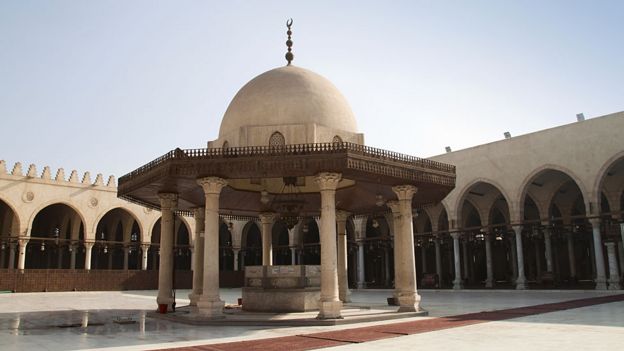
The Mosque of Amr ibn al-As in Egypt, where Birmingham's Koran seems to have orginated
Paris match
This is because academics are increasingly confident the Birmingham manuscript has an exact match in the National Library of France, the Bibliotheque Nationale de France. The library points to the expertise of Francois Deroche, historian of the Koran and academic at the College de France, and he confirms the pages in Paris are part of the same Koran as Birmingham's. Alba Fedeli, the researcher who first identified the manuscript in Birmingham, is also sure it is the same as the fragments in Paris. The significance is that the origin of the manuscript in Paris is known to have been the Mosque of Amr ibn al-As in Fustat.
'Spirited away'
The French part of this manuscript was brought to Europe by Asselin de Cherville, who served as a vice consul in Egypt when the country was under the control of Napoleon's armies in the early 19th Century.
Prof Deroche says Asselin de Cherville's widow seemed to have tried to sell this and other ancient Islamic manuscripts to the British Library in the 1820s, but they ended up in the national library in Paris, where they have remained ever since.
But if some of this Koran went to Paris, what happened to the pages now in Birmingham?
Prof Deroche says later in the 19th Century manuscripts were transferred from the mosque in Fustat to the national library in Cairo. Along the way, "some folios must have been spirited away" and entered the antiquities market.
These were presumably sold and re-sold, until in the 1920s they were acquired by Alphonse Mingana and brought to Birmingham. Mingana was an Assyrian, from what is now modern-day Iraq, whose collecting trips to the Middle East were funded by the Cadbury family.
"Of course, no official traces of this episode were left, but it should explain how Mingana got some leaves from the Fustat trove," says Prof Deroche, who holds the legion of honour for his academic work. And tantalisingly, he says other similar material, sold to western collectors could, still come to light.
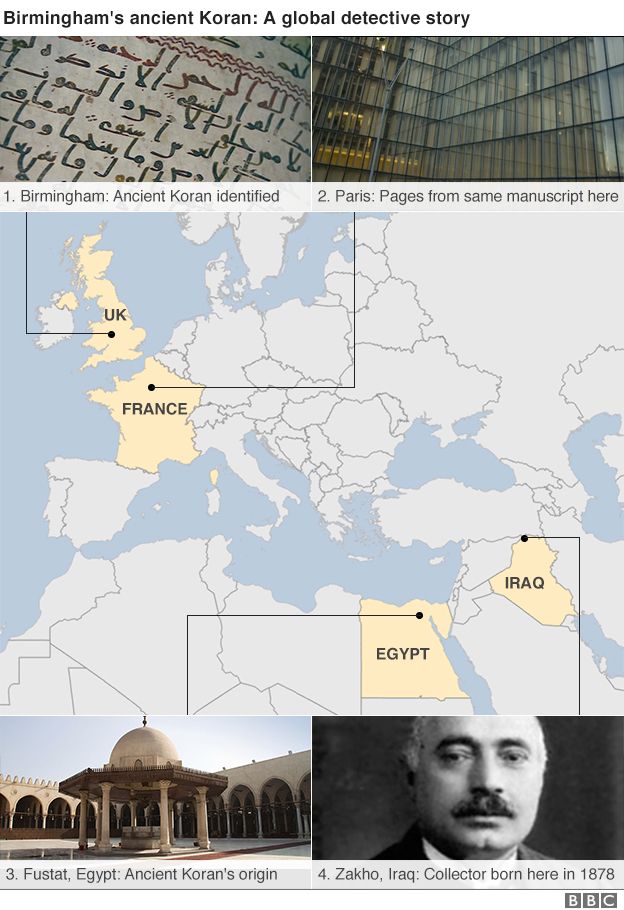
1: In summer 2015 two leaves of an ancient Koran at the University of Birmingham were identified and dated as being much earlier than anyone had anticipated and among the oldest in the world. 2: The National Library of France, Paris has leaves from the same Koran, brought from Egypt by a vice consul under Napoleon. 3: The Mosque of Amr ibn al-As in Fustat, Egypt. The fragments of the Koran in Birmingham are believed to have come from this ancient mosque. 4: Alphonse Mingana was born near Zakho in modern-day Iraq in 1878. He brought the manuscript to Birmingham from the Middle East on a collecting trip in the 1920s funded by the Cadbury family.
Disputed date
But what remains much more contentious is the dating of the manuscript in Birmingham. What was really startling about the Birmingham discovery was its early date, with radiocarbon testing putting it between 568 and 645.
The latest date in the range is 13 years after the death of the Prophet Muhammad in 632. David Thomas, Birmingham University's professor of Christianity and Islam, explained how much this puts the manuscript into the earliest years of Islam: "The person who actually wrote it could well have known the Prophet Muhammad."
But the early date contradicts the findings of academics who have based their analysis on the style of the text. Mustafa Shah, from the Islamic studies department at the School of Oriental and African Studies in London, says the "graphical evidence", such as how the verses are separated and the grammatical marks, show this is from a later date.
In this early form of Arabic, writing styles developed and grammatical rules changed, and Dr Shah says the Birmingham manuscript is simply inconsistent with such an early date.
Prof Deroche also says he has "reservations" about radiocarbon dating and there have been cases where manuscripts with known dates have been tested and the results have been incorrect.
'Confident' dates are accurate
But staff at Oxford University's Radiocarbon Accelerator Unit, which dated the parchment, are convinced their findings are correct, no matter how inconvenient. Researcher David Chivall says the accuracy of dating has improved in recent years, with a much more reliable approach to removing contamination from samples.
In the case of the Birmingham Koran, Mr Chivall says the latter half of the age range is more likely, but the overall range is accurate to a probability of 95%. It is the same level of confidence given to the dating of the bones of Richard III, also tested at the Oxford laboratory.
"We're as confident as we can be that the dates are accurate."
And academic opinions can change. Dr Shah says until the 1990s the dominant academic view in the West was that there was no complete written version of the Koran until the 8th Century.
But researchers have since overturned this consensus, proving it "completely wrong" and providing more support for the traditional Muslim account of the history of the Koran. The corresponding manuscript in Paris, which could help to settle the argument about dates, has not been radiocarbon tested.
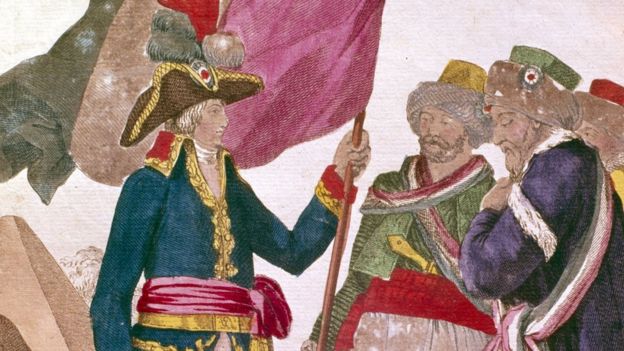
The first Koran?
But if the dating of the Birmingham manuscript is correct what does it mean?
There are only two leaves in Birmingham, but Prof Thomas says the complete collection would have been about 200 separate leaves.
"It would have been a monumental piece of work," he said.
And it raises questions about who would have commissioned the Koran and been able to mobilise the resources to produce it.
Jamal bin Huwareib, managing director of the Mohammed bin Rashid Al Maktoum Foundation, an education foundation set up by the ruler of the UAE, says the evidence points to an even more remarkable conclusion.
He believes the manuscript in Birmingham is part of the first comprehensive written version of the Koran assembled by Abu Bakr, the Muslim caliph who ruled between 632 and 634.
"It's the most important discovery ever for the Muslim world," says Mr bin Huwareib, who has visited Birmingham to examine the manuscript.
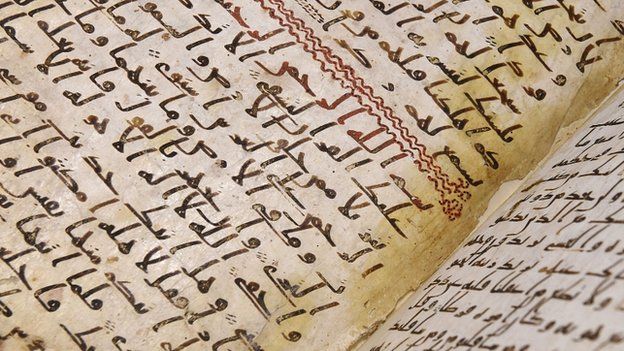
"I believe this is the Koran of Abu Bakr."
He says the high quality of the hand writing and the parchment show this was a prestigious work created for someone important - and the radiocarbon dating shows it is from the earliest days of Islam.
"This version, this collection, this manuscript is the root of Islam, it's the root of the Koran," says Mr bin Huwareib.
"This will be a revolution in studying Islam."
This would be an unprecedented find. Prof Thomas says the dating fits this theory but "it's a very big leap indeed".
'Priceless manuscript'
There are other possibilities. The radiocarbon dating is based on the death of the animal whose skin was used for the parchment, not when the writing was completed, which means the manuscript could be a few years later than the age range ending in 645, with Prof Thomas suggesting possible dates of 650 to 655.
This would overlap with the production of copies of the Koran during the rule of the caliph Uthman, between 644 and 656, which were intended to produce an accurate, standardised version to be sent to Muslim communities.
If the Birmingham manuscript was a fragment of one of these copies it would also be a spectacular outcome.
It's not possible to definitively prove or disprove such theories.
But Joseph Lumbard, professor in the department of Arabic and translation studies at the American University of Sharjah, says if the early dating is correct then nothing should be ruled out.
"I would not discount that it could be a fragment from the codex collected by Zayd ibn Thabit under Abu Bakr.
"I would not discount that it could be a copy of the Uthmanic codex.
"I would not discount Deroche's argument either, he is such a leader in this field," says Prof Lumbard.
He also warns of evidence being cherry-picked to support experts' preferred views.
BBC iWonder: The Quran
A timeline of how the Quran became part of British life
Prof Thomas says there could also have been copies made from copies and perhaps the Birmingham manuscript is from a copy made specially for the mosque in Fustat.
Jamal bin Huwaireb sees the discovery of such a "priceless manuscript" in the UK, rather than a Muslim country, as sending a message of mutual tolerance between religions.
"We need to respect each other, work together, we don't need conflict."
But don't expect any end to the arguments over this ancient document.
More stories from the BBC's Knowledge economy series looking at education from a global perspective and how to get in touch.
By Sean Coughlan, www.bbc.com
~~~~~~~~~~~~~~~~~~~~~~~~~~~~~~~~~~~
Quran Fragments, Said to Date From Time of Prophet Muhammad (pbuh), Are Found in Britain
برمنگھم یونیورسٹی سے ’قدیم ترین‘ قرآنی نسخہ برآمد
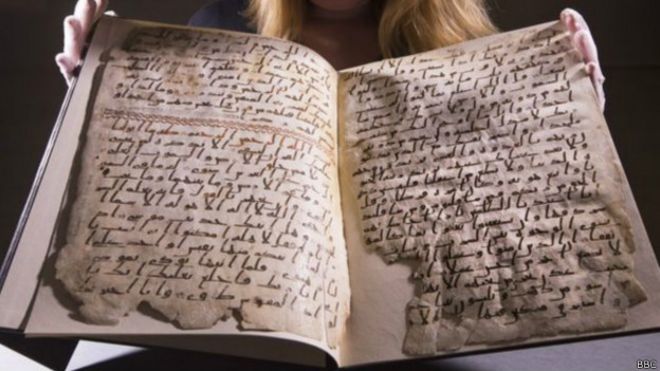
The ancient fragments of the Quran are believed to be at least 1,370 years old, potentially placing its writing within a few years of the founding of Islam. Photo by: Birmingham University
LONDON — Fragments of what researchers say are part of one of the world’s oldest manuscripts of the Quran have been found at the University of Birmingham, the school said on Wednesday.
The global significance of the ancient fragments, which sat in the university’s library for about a century, became apparent after a Ph.D. student noticed their particular calligraphy. The university sent a small piece of the manuscript, written on sheep or goat skin, to Oxford University for radiocarbon dating.
David Thomas, a professor of Christianity and Islam at the University of Birmingham, said that when the results had come back, he and other researchers had been stunned to discover that the manuscript was probably at least 1,370 years old, which would place its writing within a few years of the founding of Islam. He said the author of the text may well have known the Prophet Muhammad.
“We were bowled over, startled indeed,” Professor Thomas said in an interview. The period when the manuscript was produced, he added, “could well take us back to within a few years of the actual founding of Islam.”
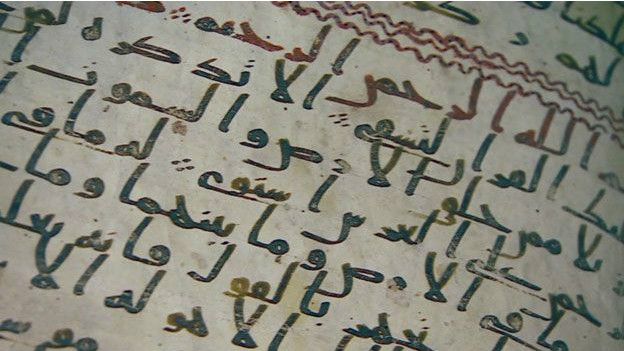
Professor Thomas said that, according to Muslim tradition, Muhammad received the revelations that form the Quran, the scripture of Islam, between 610 and 632, the year of his death. Tests by the Oxford Radiocarbon Accelerator Unit provided a range of dates and showed, with a probability of more than 94 percent, that the parchment dated from 568 to 645.
Consisting of two parchment leaves, the manuscript contains parts of suras, or chapters, 18 to 20. For many years, the manuscript had been mistakenly bound with leaves of a similar Quran manuscript.
During the time of Muhammad, Professor Thomas said, the divine message was not compiled into the book form in which it appears today. Rather, the revelations were preserved in the “memories of men,” and parts of it were written on parchment, stone, palm leaves and the shoulder blades of camels.
Professor Thomas said the discovery could help resolve a longstanding debate between Muslims who believe that the Quran was completed by the time Muhammad died and some scholars who contend that the Quran was changed or expanded in the century after his death.
He said the text of the two folio pages discovered in Birmingham corresponded closely to today’s Quran, supporting the more traditionalist view of the holy book’s inception.
The manuscript is in Hijazi script, an early form of written Arabic, and researchers said the fragments could be among the earliest textual evidence of the Islamic holy book known to survive. Susan Worrall, the director of special collections at the Cadbury Research Library of the university, said the discovery was significant for Muslim heritage and for the study of Islam.
Professor Thomas said the manuscript would be put on public display, although the fragments were organic and extremely delicate. He said the university had no intention of parting with the manuscript.
The manuscript is part of a collection of more than 3,000 documents from the Middle East amassed in the 1920s by Alphonse Mingana, a theologian and historian who was born in what is now Iraq. His document-gathering expeditions to the Middle East were funded by Edward Cadbury, a member of the famous chocolate-making family.
In Birmingham, which has a large Muslim population, the discovery of the ancient manuscript was greeted with joy.
Appearing moved, Mohammad Afzal, chairman of the Birmingham Central Mosque, said he had been granted access to the manuscript. “I am honored to see this manuscript, which is unique,” he said. “This goes back to the very early stages of Islam. All the Muslims in the world would love to see this manuscript.”
Muhammad Isa Waley, curator for the Persian and Turkish Section at the British Library in London, said it was an “exciting” discovery.
“We know now that these two folios, in a beautiful and surprisingly legible Hijazi hand, almost certainly date from the time of the first three caliphs,” he said. He added that, according to classic accounts, it was under the third caliph, Uthman ibn Affan, that the Quranic text was compiled and the suras edited into the order familiar today.
Professor Thomas predicted that the discovery would make Birmingham a draw for Muslims and scholars. But he noted that Muslims did not require a physical manifestation such as a manuscript to feel close to the Quran, because for many, it was essentially an oral experience to be recited, memorized and revered.
“The Quran,” he said, “is already present in the minds of Muslims.”
Quran Fragments, Said to Date From Time of Muhammad, Are Found in Britain
by DAN BILEFSKY, mobile.nytimes.com
برمنگھم یونیورسٹی سے ’قدیم ترین‘ قرآنی نسخہ برآمد
پروفیسر ڈیوڈ تھامس کا کہنا ہے کہ ’اس تاریخ سے یہ کہا جا سکتا ہے کہ اسلام کے چند سال بعد کا نسخہ ہے۔‘
برطانیہ کی برمنگھم یونیورسٹی کی لائبریری سے ممکنہ طور پر قرآن کا قدیم ترین نسخہ برآمد ہوا ہے۔
یونیورسٹی کے مطابق ریڈیو کاربن ٹیسٹ سے یہ معلوم ہوا ہے کہ یہ نسخہ کم از کم 1370 سال پرانا ہے اور اگر یہ دعویٰ درست ہے تو یہ نسخہ قدیم ترین قرآنی نسخہ ہے۔
قرآن کا یہ نسخہ یونیورسٹی کی لائبریری میں تقریباً ایک صدی سے پڑا ہوا تھا۔
برٹش لائبریری میں ایسے نسخوں کے ماہر ڈاکٹر محمد عیسیٰ کا کہنا ہے کہ یہ بہت ’دلچسپ دریافت‘ ہے اور ’مسلمان بہت خوش‘ ہوں گے۔
یہ نسخہ مشرق وسطیٰ کی کتابوں اور دیگر دستاویزات کے ساتھ پڑا ہوا تھا اور کسی نے اس کی پہچان نہیں کی۔
اس نسخے کو ایک پی ایچ ڈی کرنے والے طالب علم نے دیکھا اور پھر فیصلہ کیا گیا کہ اس کا ریڈیو کاربن ٹیسٹ کرایا جائے اور اس ٹیسٹ کے نتیجے نے سب کو حیران کردیا۔
یونیورسٹی کی ڈائریکٹر سوزن وورل کا کہنا ہے کہ تحقیق دانوں کو اندازہ بھی نہ تھا کہ یہ دستاویز اتنی قدیم ہو گی۔ انھوں نے کہا کہ ’یہ معلوم ہونا کہ ہمارے پاس قرآن کا دنیا میں قدیم ترین نسخہ موجود ہے بہت خاص ہے۔‘
آکسفرڈ یونیورسٹی کے ریڈیو کاربن ایکسلیریٹر یونٹ میں کیے گئے ٹیسٹ سے یہ بات سامنے آئی ہے کہ یہ نسخہ بھیڑ یا بکری کی کھال پر لکھا گیا ہے۔ یہ قدیم ترین نسخوں میں سے ایک ہے۔
یونیورسٹی کی ڈایریکٹر سوزن وورل کا کہنا ہے کہ تحقیق دانوں کو اندازہ بھی نہ تھا کہ یہ دستاویز اتنی قدیم ہو گی
اس ٹیسٹ کے مطابق یہ سنہ 568 اور سنہ 645 کے درمیان کا نسخہ ہے۔
برمنگھم یونیورسٹی کے عیسائیت اور اسلام کے پروفیسر ڈیوڈ تھامس کا کہنا ہے کہ ’اس تاریخ سے یہ کہا جا سکتا ہے کہ اسلام کے چند سال بعد کا نسخہ ہے۔‘
پروفیسر تھامس کا کہنا ہے کہ اس بات کے بھی قوی امکانات ہیں کہ جس نے بھی یہ لکھا وہ شخص پیغمبر اسلام کے وقت حیات تھا۔
’جس نے یہ لکھا ہے ممکن ہے کہ وہ پیغمبر اسلام کے قریب تھے۔ ممکنہ طور پر انھوں نے پیغمبر کو دیکھا ہو گا اور ان کو تبلیغ کرتے ہوئے سنا ہو گا۔ ہو سکتا ہے کہ وہ پیغمبر کو قریب سے جانتے ہوں گے۔ اور یہ ایک اہم بات ہے۔‘
پروفیسر تھامس کا کہنا ہے کہ قرآن کو کتاب کی صورت میں 650 میں مکمل کیا گیا۔
ان کا کہنا ہے کہ ’یہ کافی اعتماد سے کہا جا سکتا ہے کہ قرآن کا جو حصہ اس چمڑے پر لکھا گیا ہے کہ وہ پیغمبر اسلام کے گزر جانے کے دو دہائیوں کے بعد کا ہے۔‘
’جو نسخہ ملا ہے وہ موجودہ قرآن کے قریب تر ہے جس سے اس بات کو تقویت ملتی ہے کہ قرآن میں کوئی تبدیلی نہیں کی گئی اور وہ ویسا ہی جیسے کہ نازل ہوا۔‘
قرآن کا یہ نسخہ ’حجازی لکھائی‘ میں لکھا گیا ہے جس طرح عربی پہلے لکھی جاتی تھی۔ جس کے باعث اس بات کو تقویت ملتی ہے کہ یہ قدیم ترین نسخہ ہے۔
ریڈیو کاربن ٹیسٹ سے مختلف تاریخیں سامنے آتی ہیں۔ کچھ لوگوں کے پاس بھی قدیم نسخے موجود ہیں جس کے باعث یہ کہا جا سکتا ہے کہ ان نسخوں میں سے کوئی بھی قدیم ترین ہو سکتا ہے۔
قرآن کا یہ نسخہ ’حجازی لکھائی‘ میں لکھا گیا ہے جس طرح عربی پہلے لکھی جاتی تھی۔ جس کے باعث اس بات کو تقویت ملتی ہے کہ یہ قدیم ترین نسخہ ہے: پروفیسر تھامس
تاہم یونیورسٹی کے کیے گئے ٹیسٹ سے 645 کی تاریخ سامنے آئی ہے جس سے یہ بات ثابت ہوتی ہے کہ یہی قدیم ترین نسخہ ہے۔
برٹش لائبریری کے ڈاکٹر محمد عیسیٰ کا کہنا ہے کہ ’خوبصورت اور واضح حجازی لکھائی میں لکھے گئے یہ نسخے یقینی طور پر پہلے تین خلفا کے زمانے کے ہیں یعنی 632 اور 656 کے عرصے کے۔‘
ڈاکٹر محمد عیسیٰ کا کہنا ہے کہ تیسرے خلیفہ کے زمانے میں قرآن کا حتمی نسخہ منظر عام پر لایا گیا۔
ان کا کہنا ہے کہ مسلمان اس وقت اتنے امیر نہیں تھے کہ وہ دہائیوں تک کھالوں کو محفوظ کر کے رکھتے اور قرآن کی ایک مکمل نسخے کے لیے کھالوں کی بڑی تعداد درکار تھی۔
ڈاکٹر محمد عیسیٰ کا کہنا ہے کہ یونیورسٹی سے ملنے والا یہ نسخہ یا تو اس زمانے کا ہے یا اس سے بھی پہلے کا۔
’بہرحال اس نسخے کا ملنا اور اس پر خوبصورت حجازی لکھائی سے مسلمان بہت خوش ہوں گے۔‘
یہ نسخہ 3000 سے زیادہ مشرق وسطیٰ کے دستاویزات کے ’منگانا مجموعے‘ کا حصہ ہے جو 1920 کی دہائی میں جدید عراق کے شہر موصل سے پادری الفونسے منگانا لائے تھے۔
ان کو چاکلیٹ بنانے والی کمپنی کے ایڈورڈ کیڈبری نے سپانسر کیا تھا کہ وہ مشرق وسطیٰ جائیں اور دستاویزات اکٹھی کریں۔
برمنگھم کی مقامی مسلمان آبادی نے اس نسخے کی دریافت پر خوشی کا اظہار کیا ہے۔ یونیورسٹی کا کہنا ہے کہ اس نسخے کی نمائش کی جائے گی۔
